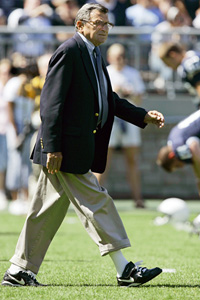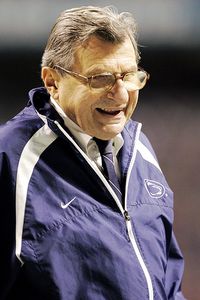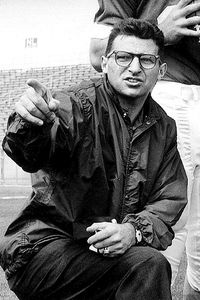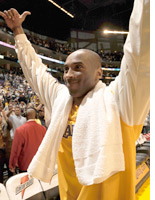UNIVERSITY PARK, Pa. -- There is the eight-year-old Paterno Library, which will serve students at Penn State University for decades to come.
There is the interfaith spiritual center on campus, and the scholarships and faculty chairs, all endowed, financially and emotionally, by Joe and Sue Paterno.

AP Photo/Carolyn Kaster
Joe Paterno's footprints have made a lasting impression during his 58 years on the Penn State campus.
All serve as testament to the impact the football coach has had on Penn State, and all are redundant. Penn State already had a building that captured what Paterno has meant to this university in his 58 years here. It is at the center of campus, looming over the green that extends nearly to Harrisburg. It is the heart and soul of the Penn State.
It is called Old Main, and if the nickname Old Main doesn't fit Paterno like a pair of rolled-up pants and white socks, nothing does. Like Old Main, Paterno is a university icon, a symbol that represents Penn State to its alumni around the world. Old Main and Paterno are repositories of political power at Penn State.
Old Main holds the offices of president Graham Spanier and his administration.
Paterno holds, well, Paterno, a two-time national championship coach and the conscience of college football for decades.
All of which is only half the definition of Old Main -- the latter half. Like Old Main, built in 1863 and rebuilt in 1930, Paterno is old.
In the end, that's what the current debate over the future of Penn State football is all about, isn't it? The Nittany Lions are only three seasons removed from going 11-1 and finishing third in the nation. They went 9-4 in each of the two seasons since. Those three seasons followed a five-year spell of mediocrity at best -- the Nittany Lions had losing records in four of those seasons (2000-04).
So, yes, let's get it out in the open. Joe Paterno is old. By measures demographic and historic, Paterno is old.
He is 81, born in Brooklyn on Dec. 21, 1926. On the night of his birth, the U.S. attorney in New York City launched a raid of 58 night clubs and restaurants to stanch the flow of holiday liquor. That's right -- Paterno came into this world during Prohibition.
Paterno arrived several months before 13-year-old Paul Bryant wrestled a bear in the Fordyce Theater.
Paterno is three and a half years younger than Yankee Stadium, which will be euthanized next year because of old age. He played at Brown in the same era as Darrell Royal played at Oklahoma. Royal retired from coaching after the 1976 season.
The Bureau of Labor Statistics, the people who provide employment statistics on the first Friday of every month, doesn't even bother to measure 80-year-old workers. They lump them in the catch-all category of "75-and-over." In March, the Labor Department estimated the workforce included 679,000 male employees at least 75 years old, or about 10 percent of that age group.
Washington is one of the few cities outside of University Park, Pa., where an 80-year-old man yearns to work long hours in the public eye. Six members of the U. S. Senate are over the age of 80. Two of them, Frank Lautenberg (D-N.J.) and Ted Stevens (R-Alaska), both 84, are running for re-election this year.
"I'm told that 90 is the new 80," Sen. Robert Byrd, D-W.Va., who turns 91 in November, told The New York Times last week.

Brian Bahr/Getty Images
Joe Paterno has a 10-4 record at Penn State since turning 80.
If that is true, maybe 80 is the new 65. According to U.S. government data, a man who turned 65 in 1991 had an average life expectancy of a shade under 15 years. When Paterno hit that demographic wall in 2006, his last complete season had come a last-play loss to Michigan away from an undefeated regular season and a berth in the BCS Championship Game.
Maybe old doesn't have the same meaning that it did a generation ago, a decade ago, or even last week.
"People are making a big deal out of this stuff," Paterno says. "I'm reacting to you because you're writing a story about the whole business about my age. I thought we could do some things. But I'm really uncomfortable talking about it. I really am. I am uncomfortable talking about it. It just seems like a waste of time."
Paterno gives a short laugh. He is sitting on a love seat in the office that he says he hates. It is an office right out of the book, "Football Arms Race for Dummies": oversized, overtrinketed, over the top.
"I got my own shower," Paterno says, gesturing down a hallway, "which I've never used."
Paterno prefers to work at his house, where he insists that he has everything he needs, including a "private telephone" and "a fax machine." He described how he watches tapes at home.
Tapes? Penn State video coordinator Nick Downs confirmed it. Downs, sounding like a typewriter repairman, said he has a dwindling stockpile of working tape decks. He uses them until they give out and then he moves to the next one.
You tease Paterno that he might have the last working VCR in Centre County. Hey, this is a guy who has donated in the neighborhood of $4 million to his employer and still buys his suits at the outlets in Reading. If it works, he's not about to throw it out.
"Don't get on me. It's a DVD/tape," he said of his home machine. "If I want to use a DVD, I use a DVD. My wife has got a computer right adjacent to the kitchen. She's got a DVD. … But I'm not much of a -- I get the information I want."
According to research that ESPN asked the NCAA to conduct, at least four men have coached college football after the age of 80, including John Gagliardi, still winning at Division III St. John's (Minn.). Like Paterno, the legendary Amos Alonzo Stagg coached major-college football after the age of 80. Stagg won 16 games at Pacific after turning 80. But he lost 33 and tied two. Since Paterno turned 80, he has a record of 10-4.
On the other hand, all four losses came in Big Ten Conference play. In the past two seasons, the Nittany Lions are 9-7 in the Big Ten; in the past eight, they are 32-32.
| Unhappy Valley |
|---|
 From the injury to linebacker Sean Lee to losing the recruiting race for Terrelle Pryor to a series of embarrasing off-the-field incidents, Penn State has endured a nightmarish offseason, writes Bruce Feldman. Blog From the injury to linebacker Sean Lee to losing the recruiting race for Terrelle Pryor to a series of embarrasing off-the-field incidents, Penn State has endured a nightmarish offseason, writes Bruce Feldman. Blog  |
Last week, wide receiver Chris Bell, already suspended for academic and other off-field issues, pulled a knife on teammate Devon Still, extending a litany of legal problems for Paterno's players over the past year. Five of them remain suspended. The university dismissed Bell from the team.
"Some people are concerned about the fact that some of our kids have misbehaved," Paterno said before Bell's arrest last week. "There's a handful of them that have misbehaved. And I think we'll get some of those guys straightened out."
Last week, university president Graham Spanier told the Associated Press that when Paterno's contract expires after the 2008 season, the university will confer with the coach to decide what is next. This from a president who hosts a monthly talk show on an NPR-affiliated public radio station called "To the Best of My Knowledge."
So Spanier, to the best of his knowledge, doesn't know when Paterno will leave, either.
The honest truth is, neither does Paterno. But he says he will know before anyone else.
"It's nice so many people are interested. It gets to be, it's almost like you can't …" He sputters before the thought bursts forth. If you want to hear it in Paterno's Brooklyn patter, come down hard on the italicized words:
"As if I would not know when I couldn't get it done, you know what I mean? … I don't need the money. I don't have anything to prove. I love this place. I always want it to be good."
So how will he know?
"If I can't go through the kind of day that I've got to go through," Paterno replies. "When I go to bed at night, I go to bed with a pad. If I fall asleep right away, say 9:30, it may be 3 o'clock in the morning I'm starting to twist and turn a little bit. I may go into my den -- it's right off our bedroom -- go in there and get a pad and work for an hour and go back to bed.
"When there isn't that sense of urgency and details, you know. How can we make So-And-So better? Do we have the right guys in the right place? … I think when that isn't a part of it, then I probably ought to get out of it. Sit around, and travel. I have no urge to do anything. Except coaching."
The public knows Paterno for his thick glasses and that full head of hair only recently begun to gray. His coaches and players know him for his obsession with details. They say he has maintained it even as he is closing his sixth decade in coaching.
"There are things that happen at practice," says his top defensive assistant, Tom Bradley. "I'll give you an example. And the kid [fourth-year corner Willie Harriott] was funny. Joe was yelling at him from like two fields over, and the kid goes, 'Scrap' -- that's my nickname, Scrap -- 'how did he see that?'
"I said, 'Hey, Willie, I've been here forever. I don't know.'
"'How did he see my hand on his [the receiver's] back from way over there?'
"'I don't know. It's like a mystery.'
"He said, 'Well, what's in those glasses?'
"'I don't know. I can't figure it out.'

AP Photo
Joe Paterno's style hasn't changed much on or off the field during his 42 years as head coach.
"… Here's the thing I try to explain to people," Bradley said. "If you just took -- and all you had was not the players but him in practice, OK? -- and you just filmed him in practice, because his attire doesn't change and he wears the same stuff, you would not know the year. I don't think it's any different from what I remember playing here. I remember doing the same stuff. He's still in every drill, coming around all over the same place. He doesn't coach from a tower, you know what I mean. He's working his way around, whatever he wants to get to."
On this April Wednesday, Paterno moves quickly back and forth on the two practice fields in Holuba Hall, the Nittany Lions' indoor practice building. He stops and explains why he watches the drills.
"If I show up, they show off," Paterno says. "You got me?"
Paterno gives quarterback Pat Devlin a talking-to and a belly rub.
"He just wanted to make sure that I understood what I need to do is get the ball in there to a running back so that they know the ball is in there," Devlin says after practice. "Today, we were doing one-on-ones [passes]. Sometimes, in one-on-ones, you just get into bad habits. There's no defenders, nobody you have to look off, so you just stare right at the receiver. So I go back there, I thought I was looking straight ahead and then looking out. He came rushing over to me. 'You're staring down the receiver! Don't do that!'"
Paterno gives fifth-year offensive lineman Mike Lucian a kick in the pants. That's usually a metaphor. Not at this practice. Paterno kicks Lucian in the seat of his pants.
"I've never snapped before in my life," says Lucian, who this spring moved from guard to center. "I'm having a lot of trouble with the shotgun snap. [Quarterback] Paul Cianciolo, another fifth-year guy, is working his butt off. It doesn't help him out when I have a bad snap. So Joe came over and gave me a kick in the rear."

Randy Litzinger/Icon SMI
A passion for coaching players still motivates Joe Paterno.
If Paterno gives his players the business, his players give it right back. As they stretched during one recent practice, according to Bradley, one player said to Paterno, "Coach, we're the only place in America where the coach is older than the trees around the practice field."
Paterno belittles the notion that he will keep coaching to make sure that he passes Florida State coach Bobby Bowden as the all-time leader in coaching victories. Last season, Paterno closed the margin from three wins to one. Bowden leads, 373-372.
"I don't care about the record," Paterno says. "I really don't. Honestly. You know when they bury you, you going to look up at your stone and say, 'Hey, I got a record?' You're dead. You're gone. I think there are other things that are more important. I think Bobby would say the same thing."
Maybe so. But don't mistake Paterno's being above the fray for his being tired of the fray.
"I'm a competitor," he says. "If I don't have that competitive urge -- you know, there's always a couple of new kids on the block. You know what I mean? You gotta be the macho guy. You know, they're not going to push me around."
Paterno means other coaches. But the competitor in him won't let anonymous voices, be they on "the Web site," as he refers to the Internet, or on the Penn State board of trustees, get in his way.
"Some people said, 'You're being selfish.' Sure, I'm being a little selfish. But after 58 years, I think I got a right to be a little selfish."
A few months ago, Paterno traveled to Washington to attend an 80th birthday celebration for his friend, William Schreyer, the former CEO of Merrill Lynch, and former U.S. Ambassador Anne Armstrong. Schreyer, a 1948 graduate of Penn State, has donated $58 million to his alma mater. Paterno, in his toast to his friend Bill, told a story of being in Washington with Schreyer shortly after the 1992 election and being invited to the White House by President George H.W. Bush.
"Here was the most important, powerful, single position in the world," Paterno says, "and you know what? They're taking the pictures off the wall. All right? No guns. All right? No coups."
That rendition of patriotism, so stirring that another attendee, former U.S. Sen. Sam Nunn, D-Ga., walked over to Paterno and said, "That was wonderful."
The U.S. government has an orderly succession of power, outlined in the Constitution and tested by death, scandal and the voice of the voters. Penn State football does not. The angst in Nittany Lion country over how much longer Paterno will coach simmers. Some fans want Paterno to retire. Some just want certainty. Paterno wants them to trust his judgment, even at 81.
Ivan Maisel is a senior writer for ESPN.com. Send your questions and comments to Ivan at ivan.maisel@espn3.com.
Original here



 Ball hit by Mickey Mantle on April 17, 1953 at Griffith Stadium to set a new distance record for home runs.
Ball hit by Mickey Mantle on April 17, 1953 at Griffith Stadium to set a new distance record for home runs. 










 From the injury to linebacker Sean Lee to losing the recruiting race for Terrelle Pryor to a series of embarrasing off-the-field incidents, Penn State has endured a nightmarish offseason, writes Bruce Feldman.
From the injury to linebacker Sean Lee to losing the recruiting race for Terrelle Pryor to a series of embarrasing off-the-field incidents, Penn State has endured a nightmarish offseason, writes Bruce Feldman. 
